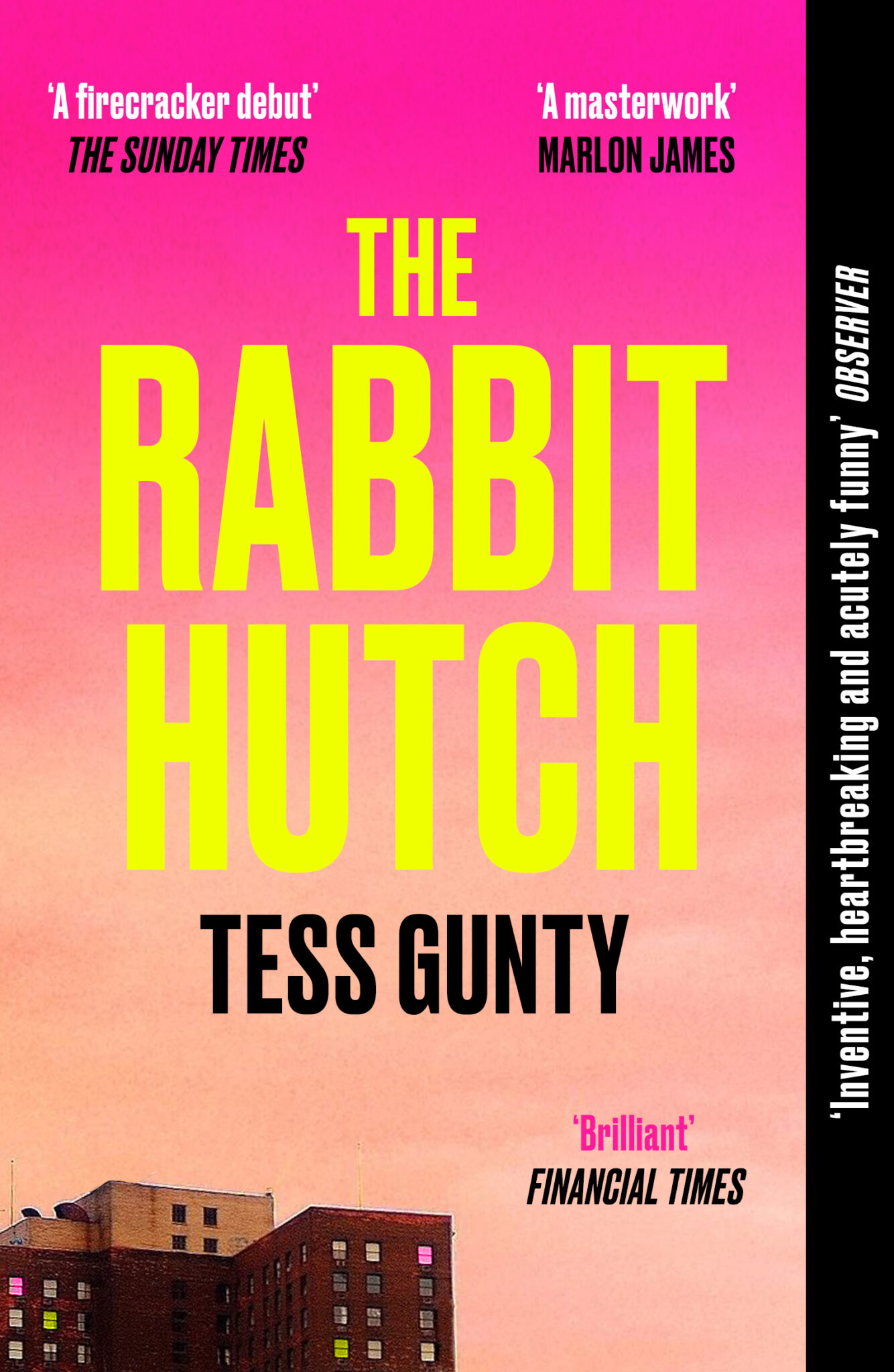Natasha Carr-Harris reviews The Rabbit Hutch by Tess Gunty
Tess Gunty’s widely acclaimed debut novel takes place in fictional Vacca
Vale, Indiana, an obscure town in the Rust Belt of America which we discover early on has topped Newsweek’s notorious list of “Top Ten Dying American Cities” (31). At the edge of town, a motley cast of characters fight to survive and aspire to thrive in separate units of a low-cost housing complex, a building named “La Lapinière”, or “The Rabbit Hutch”. Unfettered by the restraints of chronology, Gunty takes the reader on a polyphonic dance that offers both fleeting glimpses and cutting insights into the sad decline of a once bustling industrial centre and the characters who struggle haplessly against the oppressive systemic forces that disrupt and upset their lives.
There are grand, overarching themes which loom portentously over the unfolding personal narratives, omens of ecological doom and economic collapse and a depressing paucity of societal communion, all echoed by carefully detailed accounts of the city’s deterioration and stricken portraits of its unhappy denizens. What we learn about Vacca Vale’s decline throughout the novel seems to substantiate the current discourse on the predicament of America’s Rust Belt. The Vacca Vale river, which cuts through the city’s centre, is hopelessly polluted, countless businesses foreclosed, shops, buildings and houses abandoned, streets littered with trash, and we soon learn that the town’s only bit of untouched beauty, an expanse of park called Chastity Valley, is set to be transformed into a cluster of condominiums as part of a development plan.
Blandine, the eighteen year old star of the novel, opposes the development plan and stages an unnerving protest during a celebration dinner for its official launch. We witness her quietly agitated moments before the attack, poised on the precipice of dissidence, desperate to defend the Valley, embroiled in a strange, unsettling conversation with Joan, another resident of the Rabbit Hutch. The actual attack occurs off page, but I was far more interested in these preceding moments of inner turmoil as they set the stage for what we will come to learn and expect of Blandine: her fascination for mysticism, her uncompromising principles and ideals, and above all, her particular brand of profound loneliness.
Precocious yet troubled, Blandine strikes me as a conduit for important and necessary criticisms about the state of her hometown and the crises that permeate our reality at large. Freshly aged out of the foster system and unceremoniously thrust into adulthood, we find her cohabitating with three teenage boys who come from similarly unstable backgrounds, grappling with the trauma of having been betrayed by a mentor figure, a teacher from her old school. As much as her intelligence helps her escape her pain through her readings of the mystics, she is bereft of the resources to actually help herself, and her awareness of how much is beyond her control
contributes to a terrible anger.
Described as beautiful in an unassuming, ethereal way, Blandine is undoubtedly set apart from the other characters, but I found a great deal of her sentiments, beliefs, habits and thoughts to be intensely relatable and resonant. For instance, in a conversation with Jack, one of the boys she lives with, Blandine delivers a scathing diatribe on the exploitative perils of social media and its contribution to a cultural erosion that leaves room for little else than artificiality and incessant comparison. In response to Blandine’s deliberate abstinence from social media, Jack accuses her of snobbery, to which Blandine replies, “Not at all. On the contrary, I’m too weak for it” (177). For me, this attitude succinctly encapsulates an aggravating paradox about people who avoid social media and those who long to break free from it: that they are principally opposed to the proliferation of “hacking, politically nefarious robots, opinion echo chambers, [and] fearmongering,” yet equally as susceptible to its addictive algorithm (177). But as articulate as Blandine is when it comes to expressing her discontentment, she is helpless to effect any real change. She is as much a relatable nobody as a burgeoning mystic, all of which makes her role in the novel’s harrowing climax both tragic and poetically satisfying.
True to its polyphonic structure, the novel is stylistically experimental with a wide range of perspectives and voices which range from finessed prose with rhetoric, metaphors and sensory detail to the colloquial chatter of a teenage boy. There was one chapter I found quite striking in its unprecedented structure: in the aftermath of the novel’s climax, nineteen year old Jack relays the sequence of events that culminate in the story’s final, violent confrontation through a chapter composed solely of single-sentence paragraphs. Entirely devoid of effusion, the terse list of one-liners resembles a factual police report and I was left with a curious sense of emotional obstruction and an understanding that perhaps for Jack, the horror of what transpired necessitates a sort of removed detachment.
Here and there, the fragmented narrative dips delicately into surrealism, never departing too far from the banalities of real life. Many of the characters come from different walks of life and subsequently face a scattered array of hardships unique to their backgrounds, though they share humanising attributes. But before they are real, they are merely strange. One of the first things we learn about Moses Robert Blitz, for instance, is that he habitually stages nocturnal attacks by covering his nude body in glow-stick liquid and breaking into the houses of his enemies to frighten them. What could possibly motivate his bizarre behaviour emerges as puzzle pieces from a painful past that he cannot let go of; these pieces all point to a mother who hurt him deeply, and has recently skirted any possibility of resolution or reconciliation through death. Meanwhile, the mother in question, the Hollywood starlet Elsie Blitz, is as haunting and formidable in her living moments as she is in death. In a truly innovative auto-obituary, she offers a haphazard collection of life lessons, chastises her adult son for his nocturnal escapades, and outlines a startlingly vivid encounter with Death himself. Moses eventually arrives in Vacca Vale on one of his punitive missions, but he and Elsie are the only two characters whose lives actually take place outside of the town. And while they certainly embody what the dying town lacks—namely, wealth—it is equally as clear that they are not impervious to its smog of despair. The relationship between Moses and Elsie, which explores fundamental misunderstandings and limitations on both ends, was, for me, one of the novel’s most convincing portraitures of a dysfunctional relationship, and certainly my favourite. As Gunty pithily summarises: “In the end, there was a woman and a man. But the man was too much son and the woman was too little mother” (166).
I enjoy my fiction with a touch of surrealism, which exercises my imaginative faculties, but what I was not expecting to enjoy was how much the internet features throughout the story. We live in a virtual age, after all, though this is a fact that I am not always at peace with, so when a book succeeds in depicting the online world authentically, replete with internet vernacular, emojis, typos, and the kind of unsightly language borne behind the safety of anonymity, I find myself genuinely paying attention. One of the Rabbit Hutch tenants, Joan, ekes out a living screening obituary comments for “foul language, copyrighted material, and mean-spirited remarks about the deceased”, amongst other varieties of unruly internet conduct (34). In a chapter wholly comprised of obituary comments, Gunty relays a barrage of offensive material that Joan is forced to delete. At first glance, the comments seem nonsensical and random, as internet content so often is, but there is, in fact, much to glean from the remarks on what is ailing us all. One comment, in all caps, promotes a young hopeful’s new music album; another spouts political non-sequiturs; yet others spell out conspiracy theories, sexual propositions, requests for charity, and even existential provocations. In these pleas for attention and shouts into the void, I gathered a core truth about what Joan calls the “collective American subconscious”: that America may be lost, but Americans are fighting to find themselves.
I have included in my review those moments from the book that struck me most viscerally, that I can recall without effort and feel a great urge to discuss with others, but I have no doubt there is much I am forced to overlook—or have not yet discovered—and I would urge any reader to look for those moments of humour and insight. As much as it comments on the state of America, The Rabbit Hutch meditates equally on modernity, and people, such that while my reader’s greed longs for more, I have to defer to the novel’s unresolved ending, which mimics what we know of the questionable nature of life.
Gunty, Tess. The Rabbit Hutch. London, Oneworld Publications, 2022. Print.

